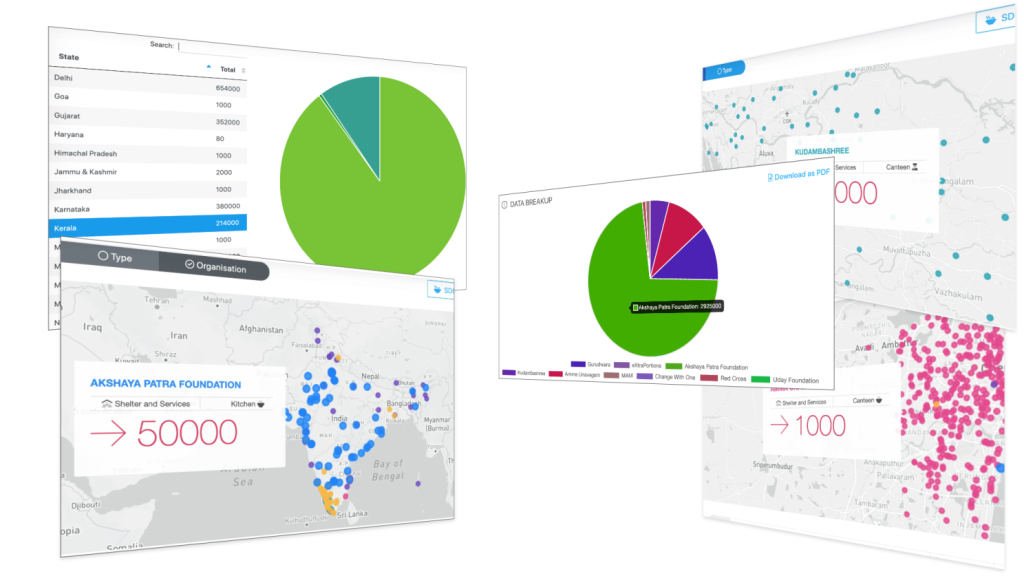
The Global Hunger Index (GHI) 2023 ranked India 111 out of 125 countries. The Indian Government promptly rejected the ranking, saying that it was a flawed measure of ‘hunger’. GHI is calculated by aggregating and normalizing multi-dimensional data, which include mortality rates of children under five, undernutrition among children, and undernourishment from food supply shortages.
India has a very robust food security program through its Public Distribution System (PDS) and a history of providing mid-day meals in its schools. Several regional governments and NGOs distribute free and subsidized meals to vulnerable populations using community kitchens. Have all these efforts not had much impact towards reducing hunger? Or, is the low score a result of regional imbalances? Can we use the underlying data to guide us in formulating policies that help direct investments that can lead to zero hunger?
While the index ranks countries, it is not actionable. A low or high ranking does not guide policymakers in taking corrective actions that can improve the outcome. Further, the degree of correlation of the three selected dimensions to the desired outcome is unknown and providing equal weight to all the dimensions only increases the opacity of the model. In addition, most of the data that goes toward the index are lagging indicators.Even if the goal were to be met today, the index may reflect only years later. The index is neither predictive nor prescriptive.
Some of the collected data is based on household surveys. To control costs, sample sizes are kept small, which can amplify errors when aggregated. Small sample sizes also preclude district/state level data aggregation and cannot highlight regional imbalances.
Another problem with the metric is that more than two-thirds of the score is based on statistics on children. Elderly hunger is indirectly attributed through data on food supply shortages. Many countries that rank high in the GHI recognize that food insecurity among older adults is now at epidemic levels.
Flipping the Narrative
Is there a better way to measure hunger? Turns out, there is – by looking at supply-side data. Instead of looking at hunger, we can look at the availability and accessibility of food and whether it meets the need of the vulnerable populations, and rank countries accordingly.
The UN Sustainable Development Goals (SDGs) provide a shared aspirational blueprint for achieving economic prosperity for all nations and a sustainable future for the planet. The goals recognize that economic prosperity and preserving the environment starts with removing inequities, creating opportunities, and ensuring that basic needs like food, health, and education are available to all.
To measure SDG progress, we introduced a facility-based data model and a set of actionable metrics for each of the SDGs. Facility-based data collection involves enumerating facilities of interest, visiting the facility, and collecting data on service availability, service capacity, and service readiness. Facilities include food distribution centers for SDG 2 (Food for All), health facilities for SDG 3 (Health for All), and educational institutions for SDG 4 (Education for All). We collected facility data in multiple countries in Africa, including Kenya, Cameroon, Ghana, Mozambique, and DR Congo, and have shown that a facility-based data model is far less expensive than household enumeration as done in censuses and last-mile accurate as compared to randomized household surveys.
We did a similar exercise in India, where we focused on SDG 2 and collected data on community kitchens, food banks, and organizations working towards eliminating hunger.

Hawkai Data Dashboards for mapping food distribution facilities and capacities provide insights into gaps and regional imbalances
The Akshaya Patra Foundation operates automated mega community kitchens across India that can each serve over 100,000 meals a day. Partnering with state governments, Akshaya Patra serves over 2 million mid-day meals a day leveraging their network of mega kitchens. Kudambashree, Kerala’s women community network, worked with local self-governing bodies and started over 1000 community kitchens which served over 350,000 cooked meals every day during the COVID-19 lockdowns. Amma’s Unavagam, a state funded initiative of Tamil Nadu, operates over 600 canteens serving inexpensive food. Many NGOs like the Red Cross, MAM, Gautam Gambhir Foundation, and others use individual and corporate donor funds to serve inexpensive, nutritional, and hygienic meals, with infrastructural capacities to scale on demand.
An Actionable Framework
To achieve the SDGs, we need an actionable framework that allows for all countries to consistently baseline status, identify gaps, direct investments for maximum impact, track progress, reform service delivery models, and drive actions that put them on an accelerated path towards achieving the goals.
India’s digital transformation has been a game changer for economic development and reformed service delivery models. The Digital India Stack – a Digital Public Infrastructure (DPI) – provides open standards based digital building blocks that governments and institutions can use to deliver services. Digital services built on DPIs can significantly lower costs for delivering basic services, increase financial inclusion, and ensure social equity.
The facility data is made actionable using the Metraa (Measure/Track/Reform/Accelerate/Achieve) framework, which leverages open data, digital transformation, DPI, and sustainable models of service delivery. The Metraa framework will provide transparency into progress towards goals and an accelerated path towards achieving them. Foreign aid has driven most Global South countries into either dependency or debt. The Metraa framework will foster partnerships instead of paternalism, boost local entrepreneurship instead of debt, and put countries on a path towards sustainable resilience.
To learn more about the Metraa framework, read our article — Achieving SDGs.
Achieving SDGs – An Actionable Framework
Towards Zero Hunger
The PDS outlets distribute food grains and other commodities at affordable prices and have been effective in managing food inflation and ensuring access to food, providing food security to over 800 million people. The PM POSHAN initiative covers over 100 million school going children under its mid-day meal scheme. During the COVID-19 lockdowns, it was recognized that a large number of the population that included the homeless, migrant workers, elderly, and other marginalized groups, without access to or not able to utilize a kitchen, were excluded from these benefits.
Community kitchens are key to providing universal food security. They serve localized, healthy, and inexpensive food, which keep street food prices in check, and extends benefits beyond the marginalized communities to the daily-wager and the urban poor.
The facility based data model provides a last-mile accurate, fair, and more optimistic view of India’s food security than what the GHI ranking indicates. The challenge now is to plug the gaps, scale, remove regional imbalances, and create a national food grid that is responsive, maintains service quality, and provides food security for all.
Methodologies matter, data models matter, but more than that, it is the quality of the data that determines the quality of the results. Data scientists use the term GIGO (garbage in, garbage out) when nonsense input data produces nonsense output data. It is time to move from GIGO and vanity metrics to an actionable framework and chart our path towards zero hunger.
Hawkai Data provides a Customer eXperience Platform (CXP) to quickly prototype, operationalize, and scale applications and services. Start your digital transformation today and create new business and customer experiences using Hawkai Data CXP.
If you have any questions, talk to us at info@hawkai.net, or follow us on LinkedIn at https://www.linkedin.com/company/hawkai-data/, or connect with us at https://hawkai.net.
* Header image uses photos by Loren Joseph | Unsplash, Sreehari Devadas | Unsplash









